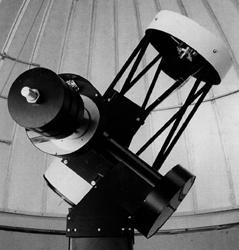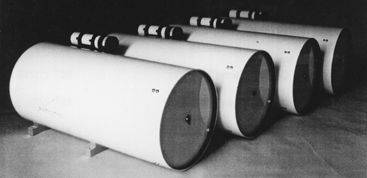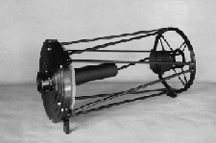
OGS German Optical Tube Assembly Common Features

Optical Designs of OGS Optical Tube Assemblies: Optical Guidance Systems manufactures precision optical systems in apertures ranging from 10" to 32". These include optical tube assemblies made in the Newtonian, Classical Cassegrain, Wright-Schmidt, Maksutov or Ritchey-Chretien design. Each is a made to order system, as each design has its own particular advantages and short comings. These can be configured for a variety of special applications including astronomy, TV auto-tracking, laser tracking, radar boresighting, IR imaging and day/night surveillance.
Our f/15 Cassegrain systems are ideal for applications where a long focal length is required and off-axis image quality is not critical. This is the case in for lunar and planetary work, where the large image scale produced by long focal length (f/10 and greater) Cassegrain telescopes is ideal. However, their restricted field of view limits their usefulness for observing extended deep-sky objects. Shorter focal length f/5 Newtonians and f/6.3 Schmidt-Cassegrains, with their wider fields, are more suitable for this class of object but will suffer from inferior off-axis image quality, spherical aberration, and coma. Where versatility and optical quality over a wide field are required, then our f/9 (even wider with optional positive lenses) Ritchey Chretien systems are preferred and are ideal for use in TV and CCD applications. We recommend the Ritchey-Chretien as it combines compact size, light weight and excellent on and off-axis image quality in one design. It is the optical design chosen for many of the new, "state of the art" large observatory telescopes. Furthermore, the reflecting systems (unlike Schmidt and Maksutov Cassegrains which employ a refractive element) are superb for UV and IR applications.
 Pictured above: OGS model 25-RCa 25" Ritchey-Chretien
Pictured above: OGS model 25-RCa 25" Ritchey-Chretienoptical tube assemblies with 99% reflectivity, protected silver coatings.
Delivered to Arnold AFB under Contract # F40650-93-C-0030
The Ritchey-Chretien is coma-free, whereas the Schmidt-Cassegrain, Newtonian and Classical Cassegrain are not. The RC design utilizes hyperbolic primary and secondary mirrors which correct coma. (Schmidt-Cassegrain instruments employ an aspheric corrector plate to correct the aberrations created by their spherical optical components). The OGS Ritchey-Chretien system has a flatter field than production SC systems of similar focal length because of its lower secondary amplification factor, 2.9x verses 5x. The resultant lower f-number also provides the RC with a wider photo-visual field and faster photographic speed. And because the Ritchey-Chretien design has only two air to glass surfaces (compared to 4 for the SC) and no refractive elements, it has less light loss and a greater spectral range than the Schmidt-Cassegrain making the RC ideal for use with CCD cameras.
Optical fabrication: Optical Guidance Systems begins the fabrication process with over sized mirrors blanks. Optical components are fabricated from low expansion materials such as ULE, Zerodur and 21A depending upon application requirements.
After polishing and interferometric testing is completed the oversized mirror blank is beveled down to provide a finished and tested clear aperture that equals the nominal aperture. Very few telescope companies provide a tested clear aperture that equals the nominal aperture. It is common for testing to performed through an aperture stop that masks the edge bevel and possibly surface defects! Optical Guidance Systems provides your research customers with the aperture they would have expected without specifying an exact clear aperture dimension. This feature provides the end user with anywhere from 2 to 4 percent more light gathering area and it provides everyone with a better quality mirror that is free of edge defects which show up even on the most expensive optical systems. Optical quality is guaranteed to be diffraction limited and supported by interferometric data. Surfaces of these all reflective systems are ALSiO coated as standard.
Optics "Specifications": Optical Guidance Systems is aware of one aerospace optical company who claims that their minimum optical standard is 1/10 wave, this translates to 1/5 wave front, but in reading the fine print you will find that this company's brochure says that this is the optical quality you will find over 90% of the surface area of the mirror. This final caveat will allow them to make this quality claim even though the edges of the mirror may have defects that are sign)ficantly worse. Another significant factor in Optical Guidance Systems optical quality is the RMS value. While it is important not to have any gross errors in the optical surface that are measured in peak to valley, the RMS measure of optical quality is far more important because it gives a truer picture of the overall surface of the mirror.
The Secondary Element: "Secondary diameter" is the measure of the actual optical element and is an indication of the minimum secondary baffle size that is required. Actual standard baffling results in a significantly larger diameter. Baffling requirements may be increased or decreased according to the baffled field of view necessary for different format cameras. Most competing manufactures list their mirror size and not the obstruction size; therefore our secondary diameters can be compared directly against competing manufactures literature. Our Optical Guidance systems optical systems sepcifications table has provided the secondary amplification specification. This specification along with mirror separation and true back focus will allow the more sophisticated customer to evaluate the optical design for their needs.
 OGS
Optical
Tube Assembly Construction: Mechanically, these systems are of a ruggedized construction and designed to withstand the
rigors of harsh environments and demanding operational requirements. Parts such as barrels, optical component supports and end
plates can be fabricated from aluminum, stainless steel or Invar. The optical tube assemblies are of partial (for truss
design) or a full rolled and welded 6061T-6 aluminum sheet. The tube wall thickness is .06" on our 8" and 10" models. Wall
thickness of .09" is use on our 12.5" - 20" models. 24" and 32" telescopes may use .125 or .090" wall thickness tubes. Open
trust tube designs are available on all models and may even be fabricated out of low expansion invar alloy to maintain mirror
separation. Please ask us for a specific quotation. Tube weight may vary by as much as 10% according to mirror thickness and
actual accessory weights.
OGS
Optical
Tube Assembly Construction: Mechanically, these systems are of a ruggedized construction and designed to withstand the
rigors of harsh environments and demanding operational requirements. Parts such as barrels, optical component supports and end
plates can be fabricated from aluminum, stainless steel or Invar. The optical tube assemblies are of partial (for truss
design) or a full rolled and welded 6061T-6 aluminum sheet. The tube wall thickness is .06" on our 8" and 10" models. Wall
thickness of .09" is use on our 12.5" - 20" models. 24" and 32" telescopes may use .125 or .090" wall thickness tubes. Open
trust tube designs are available on all models and may even be fabricated out of low expansion invar alloy to maintain mirror
separation. Please ask us for a specific quotation. Tube weight may vary by as much as 10% according to mirror thickness and
actual accessory weights.
After being checked for roundness, the tubes are reinforced with rings at the optical and saddle attachment points. The tube is sanded, degreased and prepped with an acid etching primer before the exterior is painted with Mercedes white urethane paint, this is then clear coated and again polished. All other aluminum components are anodized and coated to resist corrosion. All fasteners are made of stainless steel.
Rack and Pinion focusers are provided to Optical Guidance Systems by Astro Physics company of Rockford Illinois and Takahashi of Japan. These focusers may be removed if the customer is planning on using electronic secondary focusing exclusively. Alternatively, we can design and furnish custom hardware mounting points to suit a variety of accessories.
The experience gained by years of fabricating advanced consumer systems, tracking telescopes and high accuracy computer controlled pointing systems for the U.S. Military (where optical stability and alignment are critical) has been extended to the design of our current production telescope's optical component supports. The OGS "Kinematic Primary Mirror Mount" supports the mirror rigidly, while allowing for differential coefficients of expansion between the mirror and its mount. The primary is supported at its center of gravity and is thus self-balancing. The secondary mirror mount design provides rigid support and allows for counter balancing to achieve near perfect boresight and alignment stability. Optical collimation adjustment screws are widely spaced and provide precise collimation through fine movement and secure locking.
Telescopes of 20" and larger employ a stepper motor and lead screw to translate the secondary mirror to provide increased or decreased back focus; this is a feature that is available with the smaller aperture telescopes. Translation linearity and repeatability is assured by a pre-loaded ball slide. The lead screw is supported by two stainless steel thrust bearings to stabilize focus during a change in instrument attitude. An anti-backlash beam coupling is placed between the stepping motor and lead screw. At the focus of the telescope is provided a rugged, oversized rack and pinion focuser. It can hold several pounds of equipment and can be motorized to provide precise electronic focusing when translation of the secondary is not needed.
OGS tube assemblies are equipped with slewing handles at the back of the telescope and full length counterweights on both sides to facilitate symmetrical balancing of the telescope. Our finder telescope includes an illuminated Polaris alignment reticle to aid in the set up and use of the instrument. Finally, all OGS telescopes are provided with a sealing mirror cover with an off-axis aperture for solar filters, or so that the telescope may be used at reduced aperture as an unobstructed system.
Available options include:
- Auxiliary lens to reduce or extend effective focal length
- Motorized Focus
- Projected reticles for measurement or guiding
- Filter Wheel assemblies
- Barrels can be closed with the addition of windows and sealed and pressurized
- Relaxed Specification Optics for Lidar or other less demanding applications
- Special reflective coatings for improved transmission in the visible, ultraviolet or infrared are available.
Go back to OGS Products page
Contents Copyright 1994-2000 Company Seven - All Rights Reserved

